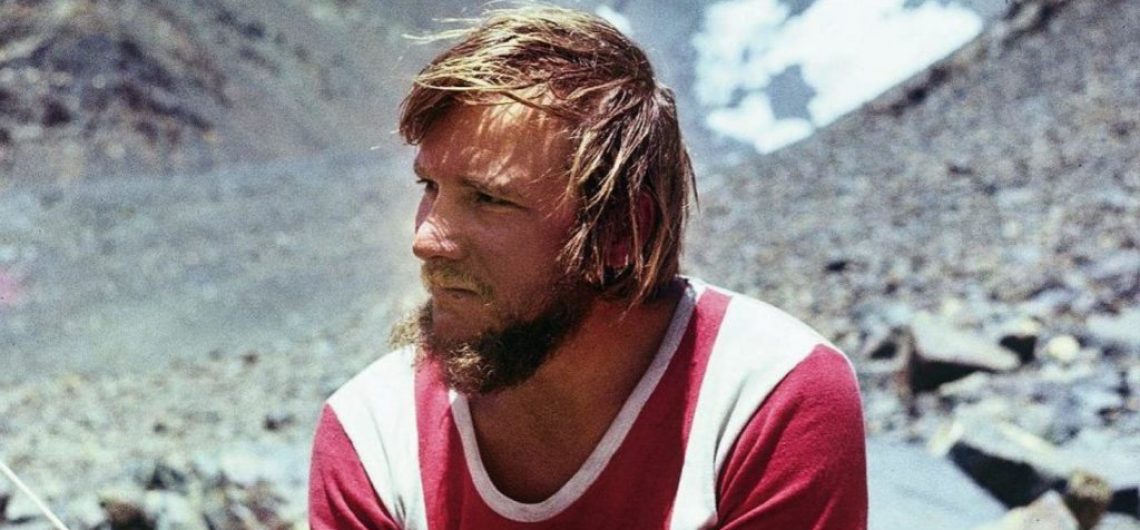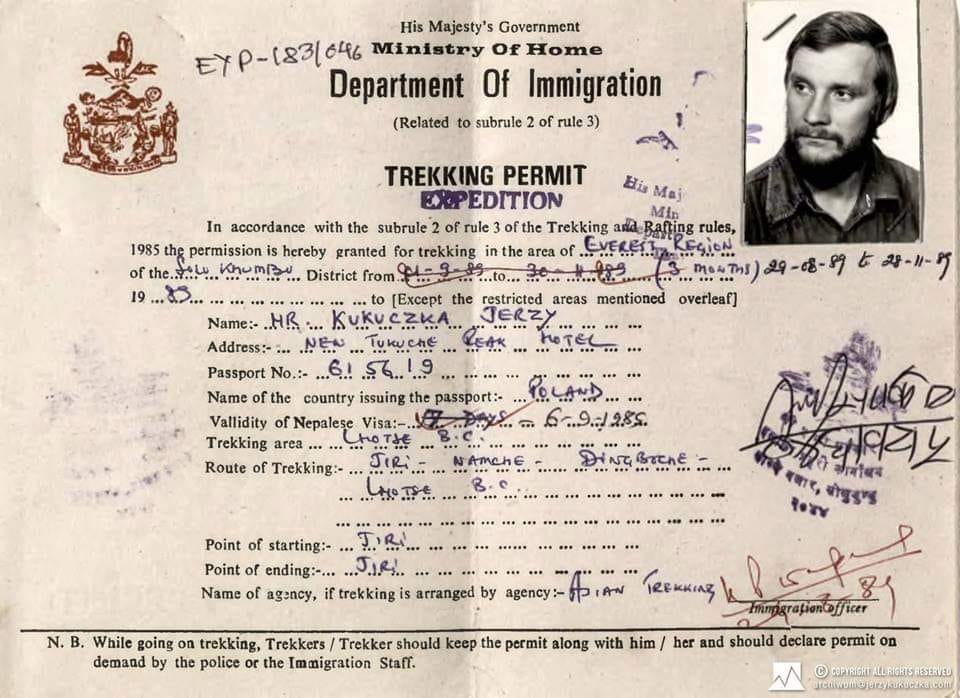Today marks 33 years since Polish mountaineer Jerzy Kukuczka passed away while climbing Lhotse on October 24, 1989. A true legend of high-altitude Himalayan mountaineering, Kukuczka was the second person, after Reinhold Messner, to ascend all fourteen Eight-thousanders.
His experience is staggering. He scaled all 14 8,000-meter peaks on the planet in eight years, including four during the winter. He was among the first to regularly climb above 8,000 meters without additional oxygen and a pioneer of the Alpine style. He accomplished all of this on a low budget, using homemade and secondhand equipment, plus funds obtained in his native Poland through hard labour and shady business dealings.
Jerzy Kukuczka of Poland passed away on this day thirty-three years ago while attempting to scale the unclimbed south face of Lhotse in Nepal. He is widely regarded as one of the greatest high-altitude climbers of all time, but his claim to fame may be that he is the second person in history to successfully summit all 14 eight-thousanders. Despite the evident economic difficulty Poland was going through under the Communist government, he accomplished this on September 18, 1987, just eleven months after Reinhold Messner, and in less than eight years.
However, Kukuczka’s legacy can be found in the immaculate quality of his ascents, not in the enormous number of routes, the speed of his climbs, or the renowned “Himalayan Crown” distinction.
Often compared to Reinhold Messner
Reinhold Messner, with whom he competed to complete the so-called Crown of the Himalayas, is frequently compared with Kukuczka. Even though Kukuczka completed the race faster and with more flair, Messner still prevailed.
Take nothing away from Messner, who established six new routes on summits higher than 8,000 meters. Kukuczka scorched 10, If given the option, he declared, “I would always choose the path less traveled by others.”
If they had been prepared to forgo style, both guys could have finished the table more quickly. It was a race, despite the fact that both parties downplayed their competitiveness.
In order to win the prize, Messner took the extraordinary step of conquering two summits in the autumn of 1986, but when Kukuckza finished a year later, Messner was among the first to telegram Kukuckza to express his admiration. He wrote, “You are wonderful; you are not second.”
Years later, Messner remarked that Jurek Kukuczka “was in my perspective the leading climber worldwide in high altitude from 1980 up to 1989 for the reason that he was intellectually and physically very strong,” adding that Kukuczka was not one for philosophical debates or protracted talks. “He made a decision and went.”
A legendary Polish mountaineer
What genuinely set Jurek different were his goals and the methods he used to achieve them; his “how” and “why” were what made him stand out. In fact, he created ten new routes while ascending all 14 of the world’s highest summits, practically all of which were done in an alpine fashion. He only used additional oxygen on Everest; he climbed alone up Makalu’s unexplored NW Ridge. In addition, three of these four historic first winter ascents of these Himalayan giants were accomplished during the winter:
Andrzej Czok and Artur Hajzer summited Dhaulagiri on January 21, 1985; Kanchenjunga on January 11, 1986; and Annapurna I on February 3, 1987. It’s important to note that his fourth winter giant, Cho Oyu, was scaled on February 15, 1985, immediately following Dhaulagiri. This was just seven days after Kukuczka reached Cho Oyu base camp and just three days after his Polish climbing partners Maciej Berbeka and Maciej Pawlikowski made the first-ever winter ascent.
1948 saw Kukuczka’s birth in Katowice, Poland, and he began climbing mountains at the age of 17. From the nearby Tatra mountains, he moved swiftly to the Alps, then to Alaska and the Himalayas.
He undoubtedly belonged to the elite group of Polish Himalayan mountaineers, together with other legends like Wojciech Kurtyka, Wanda Rutkiewicz, and Krzysztof Wielicki, to name just a few. His physical strength, fortitude, desire, and capacity for endurance were famous.
In many ways, Kukuczka’s masterpiece was his new route on the beautiful, unclimbed south face of K2 in 1986, which he and Tadeusz Piotrowski ascended alpine-style after undergoing extreme hardship and staying in four bivies during the ascent alone. Their triumph pushed the boundaries of Himalayan mountaineering to new heights. Kukuczka himself rated this as the most challenging climb he had ever undertaken at altitude.
Sadly, Piotrowski’s tragic death while descending the Abruzzi Spur and the devastating 1986 climbing season on K2, which saw a startling 13 fatalities, overshadowed this historic accomplishment.
After finishing the “Himalayan rosary” in 1987, for which Kukuczka won the title of Man of the Year in his native Poland, he did not take the accolades lying down and bask in the limelight. The exact opposite. He returned to the Himalayas in 1988, where he and Artur Hajer developed a new alpine route up the South Face and East Ridge of Annapurna I East. His main focus, however, was on the unclimbed south face of Lhotse, a challenge that many have referred to as both impossible and the final major Himalayan difficulty. He visited Nepal once more in 1989, this time accompanied by Ryszard Pawlowski. The two made quick progress up the mountain after surviving months of bad weather when the much-anticipated weather window finally materialized. They established a bivouac at about 8200 meters, then hiked on in excellent conditions early the following morning with the summit only a few hundred meters away.
The climbing permit for climbing authorization granted to Jerzy Kukuczka, a legendary mountaineer, by the Nepal Government, prior to his ill-fated ambition to conquer the treacherous South wall of Lhotse. Tragically, he perished during his ambitious pursuit to ascend the unnavigated South Face of Lhotse in Nepal on 24 October 1989.
How Jerzy Kukuczka met his tragic death
On the morning of October 24, 1989, Kukuczka roped into a 7mm rope and took the lead, but he lost his balance when navigating a blank slab. Kukuczka died when the rope snapped, causing him to fall. Pawlowski managed to descend alone from above 8000 meters, relying on all of his prior climbing knowledge. One of the finest alpinists of all time, Kukuczka, age 41, was never discovered alive.
Jerzy Kukuczka 8000m peaks
1979 – Lhotse (Nepal) – West Face, normal route, alpine style. With Andrzej Czok, Zygmunt Andrzej Heinrich and Janusz Skorek, 4/10/1979
1980 – Mount Everest (Nepal) – South Pillar, first ascent. With Andrzej Czok, 19/05/1980
1981 – Makalu (Nepal) – NW Ridge, new route, alpine style. Solo. 15/10/1981
1982 – Broad Peak (Pakistan) – West Spur, normal route, alpine style. With Wojciech Kurtyka, 30/07/1982
1983 – Gasherbrum II (Pakistan) – SE Spur, first ascent, alpine style. With Wojciech Kurtyka, 23/06/1983
1983 – Gasherbrum I (Pakistan) – SW Face, first ascent, alpine style. With Wojciech Kurtyka, 23/07/1983
1984 – Broad Peak (Pakistan) – Traverse of North, Central and Main Summit, first ascent, alpine style. With Wojciech Kurtyka, 13-17/07/1984
1985 – Dhaulagiri (Nepal) – NE Spur normal route, first winter ascent. With Andrzej Czok, 21/01/1985
1985 – Cho Oyu (Nepal) – second winter ascent, new route up SE Pillar. With Zygmunt Andrzej Heinrich, 13/02/1985
1985 – Nanga Parbat (Pakistan) – SE Pillar first ascent. With Carlos Carsolio, Zygmunt Andrzej Heinrich, Sławomir Łobodziński, 13/07/1985
1986 – Kanchenjunga (Nepal) – first winter ascent, SW Face normal route. With Krzysztof Wielicki, 11/01/1986
1986 – K2 (Pakistan) – South Face, first ascent, alpine style. With Tadeusz Piotrowski 8/07/1986
1986 – Manaslu (Nepal) – NE Face + E Ridge, new route, alpine style. With Artur Hajzer, 10/11/1986
1987 – Annapurna I (Nepal) – first winter ascent via North Face. With Artur Hajzer, 3/02/1987
1987 – Shishapangma (China) – West Ridge, first ascent, alpine style, West Ridge. With Artur Hajzer, 18/09/1987
1988 – Annapurna East (Nepal) – South Face + E Ridge, new route, alpine style. With Artur Hajzer, 13/10/1988
![]()



Comments